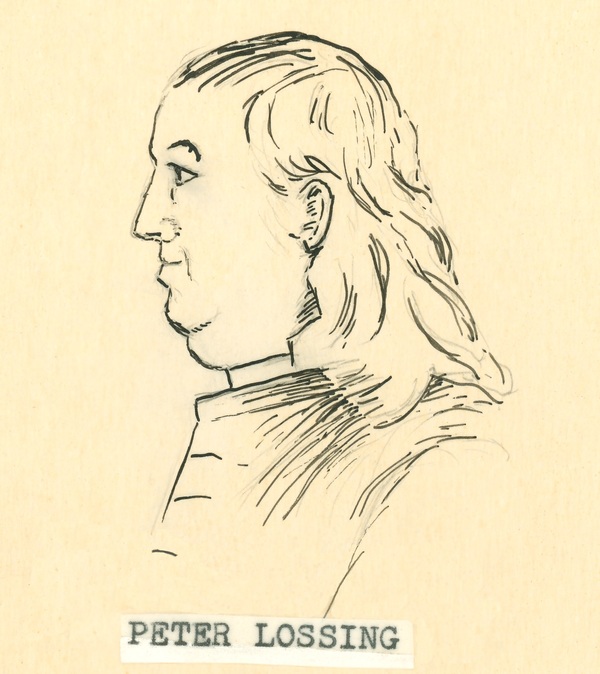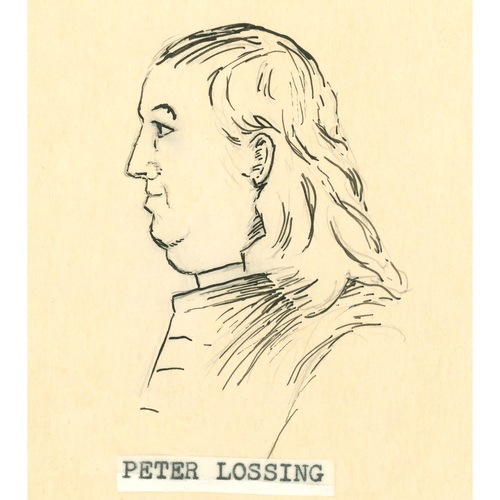
Source: Link
LOSSING, PETER, colonizer, Quaker religious leader, and surveyor; b. 11 Oct. 1761 in Dutchess County, N.Y., son of Nicholas Lossing and Christina Woolweaver; m. first 15 Oct. 1781 Hannah Brill, and they had four sons and at least two daughters; m. secondly between 1799 and 1806 Catherine Delong, a widow whose married name had probably been Vanderburg, and they had one daughter; d. 23 April 1833 in Norwich Township, Oxford County, Upper Canada.
The ancestors of Peter Lossing were Dutch and had immigrated to the colony of New York in the mid 17th century; one of his nephews, Benson John Lossing, would become a well-known American historian. Lossing himself was probably a farmer and miller in New York, and he was also a member of the Oswego Monthly Meeting of the Society of Friends. In 1806 this body, claiming that Lossing “hath been neglectful in the attendance of Meetings & married a Woman out of the unity of friends, after being guilty of fornication with her,” disowned him. It was not until 1810, on the eve of his departure for Upper Canada, that he acknowledged his errors and applied, successfully, for readmission to the society.
Lossing’s decision to move to Upper Canada was inspired by his ambition to found an agricultural settlement as a method of advancing his fortunes. No large amounts of cheap land were then available in New York, and so Lossing and his brother-in-law Peter Delong looked to Upper Canada. In 1809 a relative of Lossing there, Thomas Dorland of Adolphustown Township, secured an interview for them with William Chewett* and Thomas Ridout of the Surveyor General’s Office. The administration liked the idea of a large settlement, and even Lieutenant Governor Francis Gore* discussed it with Lossing and Delong.
The two entrepreneurs were then introduced to William Willcocks*. In 1800 the government had sold large blocks of land in Norwich and Dereham (Southwest Oxford) townships in order to help finance the building of a road linking York (Toronto) with the mouth of the Trent River [see Asa Danforth]. Willcocks was one of the purchasers; the others included Peter Russell*, Robert Hamilton*, and clergymen Edmund Burke* and Robert Addison. By 1809 Willcocks was in debt and anxious to sell part of his holdings. In June 1810 Lossing and Delong agreed to buy from him 15,000 acres in Norwich for £1,875, the purchase price to be paid over a number of years as incoming settlers acquired lots. After reaching this agreement, Lossing and his brother-in-law returned to their homes, where they persuaded several people, mostly Quakers, to immigrate. In late 1810 the first settlers, led by Lossing and his family, arrived in Norwich, and over the next two years a considerable number followed. During the War of 1812 Norwich escaped the devastation inflicted on neighbouring communities by the enemy raiding parties of such men as Joseph Willcocks* and Andrew Westbrook. Following the war, and particularly during the 1820s, the settlement took firm root.
Lossing was for some years the leading figure among the settlers. Quaker religious services were begun in his home in 1811, and a school was started there in 1813. Later he gave land for a meeting-house. He also acted as a surveyor. In the 1790s Norwich Township had been surveyed first by Augustus Jones* and then by William Hambly, but the work had been done hastily and by 1811 a more complete survey was needed. When the government could not provide someone to undertake the job, Lossing volunteered. With an assistant whom he brought from the United States, Lossing, who had no training, surveyed the township and in the process dealt with the problems created by the original surveys.
Always shrewd, Lossing knew the importance of publicizing his loyalty: as soon as he had settled in the colony he told Gore of his distaste for American government – “pleasing in theory, but troublesome & frequently factious in execution” – and he reported then with satisfaction that previously disaffected people in the London District were discovering “their fears to have been illusory, and their grievances to be mostly imaginary.” As a loyal settler and as a colonizer with genuine accomplishments to his credit, he was able to forge close links with government officials, including successive lieutenant governors up to the time of Sir John Colborne*. He often suggested measures to improve the moral and economic climate of the colony. From the beginning he was consulted on the eligibility of applicants for leases of clergy and crown reserves, and in most cases he had a hand in writing the applications. He also warned the government of squatters or timber thieves on crown land in Norwich township. In 1830 the first post office there was set up in his home.
Lossing constantly promoted the economic growth of Norwich and its vicinity. He attracted a miller to Norwich and aided the man to get started. When a local promoter, Hugh Webster, wished to create small holdings for poor people who could not afford larger properties, Lossing arranged the lease of a clergy reserve lot. He was an enthusiastic supporter of schemes to improve navigation on Otter Creek, which passed through Norwich, and on the Grand River. By introducing the industrialist George Tillson* to William Warren Baldwin*, trustee for Maria Willcocks, Lossing was instrumental in Tillson’s acquisition of land in Dereham Township on which to build an ironworks.
Yet Lossing never lost sight of his own interests, and he was not above abusing the trust which his fellow settlers and the government placed in him. In his survey of Norwich his solution to the problems caused by earlier mistakes had been to create a gore, or triangle of land, adjacent to his own land. This gore cut access to the road on the third concession line. Lossing tried to have the gore declared crown land so that he could buy it and join it to his farm. When some settlers protested to the government, he took advantage of his connections in York, playing down the opposition to his scheme and the extent of improvements made in the gore by others. The result was a protracted struggle which did not end until 1835, two years after Lossing’s death. At that time the lots on the first and second concessions were enlarged and the gore absorbed.
Lossing strongly supported the cause of temperance, criticizing as early as 1819 the “unnecessary multiplication of tipling houses” in the province. In politics he was a reformer, mainly because the reformers and especially Charles Duncombe* advocated temperance and improved education. His brand of moderate reformism was not shared by his eldest son. Solomon Lossing took over as spokesman for the Quaker community in Norwich after his father’s death. In 1837 he recruited men to join the Duncombe rising.
[Carson D. Bushell of Simcoe, Ont., was kind enough to make available genealogical data on the Lossing family. r.j.s.]
AO, Hist. plaque descriptions, “Historical plaque to be unveiled at Norwich,” 26 June 1964; RG 1, A-I-6: 4646–48, 6573, 6655–56, 9394–96, 9437–38, 9975–76; C-IV, Norwich Township. Norwich and District Museum (Norwich, Ont.), Norwich Pioneer and Hist. Soc., geneal. coll., no.293; Stella Mott coll., nos.104, 117 (mfm. of Mott coll. at AO). PAC, RG 1, L3, 287a: L12/2; 289: L13/155; 290: L14/113; 305: L leases, 1801–1836/50; RG 5, A1: 4128–31, 5192–93, 20230–33. UWOL, Regional Coll., London District, Surrogate Court, estate files, 1800–39, no.219 (mfm. at AO). C. D. Bushell, Gleanings by the Bushell ([Norwich, 1984]). Brian Dawe, “Old Oxford is wide awake”: pioneer settlers and politicians in Oxford County, 1793–1853 (n.p., 1980). R. W. Macaulay, “The land dispute in Norwich Township in the London District of Upper Canada, 1811–1840” (ma thesis, Univ. of Toronto, 1982). [A. E. Poldon], 1810–1910, centenary souvenir, Norwich, Ont. (Norwich, 1910). C. [F.] Read, The rising in western Upper Canada, 1837–8: the Duncombe revolt and after (Toronto, 1982). G. E. Reaman, The trail of the black walnut (Toronto, 1957). Max Rosenthal, “Early Oxford County post offices,” BNA Topics (Toronto), 26 (1969): 204–6.
Cite This Article
Ronald J. Stagg, “LOSSING, PETER,” in Dictionary of Canadian Biography, vol. 6, University of Toronto/Université Laval, 2003–, accessed January 3, 2026, https://www.biographi.ca/en/bio/lossing_peter_6E.html.
The citation above shows the format for footnotes and endnotes according to the Chicago manual of style (16th edition). Information to be used in other citation formats:
| Permalink: | https://www.biographi.ca/en/bio/lossing_peter_6E.html |
| Author of Article: | Ronald J. Stagg |
| Title of Article: | LOSSING, PETER |
| Publication Name: | Dictionary of Canadian Biography, vol. 6 |
| Publisher: | University of Toronto/Université Laval |
| Year of publication: | 1987 |
| Year of revision: | 1987 |
| Access Date: | January 3, 2026 |



